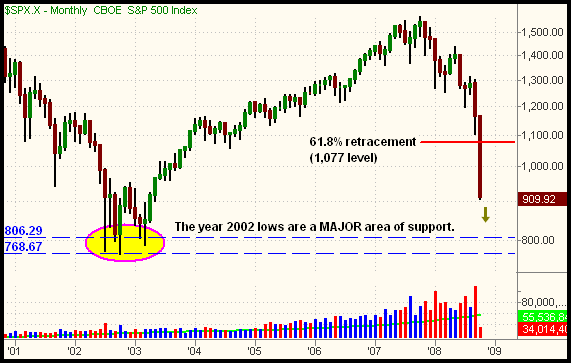|
The Wagner Daily ETF Report For October 10
A positive earnings report from IBM helped stocks get off to a positive start yesterday morning, but the situation turned horribly dour late in the afternoon. A seventh straight day of losses saw the Nasdaq Composite plummet 5.5%, the Dow Jones Industrial Average 7.3%, and the S&P 500 7.6%. The small-cap Russell 2000 suffered a whopping 8.7% drop, as the S&P Midcap 400 fell 7.2%. All the major indices closed at their worst levels of the day.
Volume receded a bit below the previous day's levels, but was still well above average levels. Total volume in the NYSE declined 10%, while volume in the Nasdaq dipped 17% lower. Market internals, of course, were horrible. Declining issues outnumbered advancing issues by more than 10 to 1. In both exchanges, declining volume smashed advancing volume by a margin of approximately 14 to 1.
Last week, we looked at the long-term charts of the major indices, and discussed how they were testing support of their 61.8% Fibonacci retracements from their October 2002 lows to October 2007 highs. We said a confirmed break of the 61.8% retracement levels could lead to complete reversals back down to the vicinity of their 2002 lows. However, we certainly didn't expect that to happen just one week later! More commonly, a two-thirds retracement of a long-term uptrend first leads to a significant, tradeable bounce. Then, traders and investors typically sell into strength of that rally, sending the indexes on the final move back down to the ultimate lows. This time, a bounce was nowhere to be found. So far this month, which is not even half over, the S&P 500 has dropped an astonishing 22%. Looking at the monthly chart below, notice how the index is now just over 100 points (approximately 12%) above its lows of the 2000 - 2002 bear market:

The bad news is downside momentum is now so strong that it's entirely feasible for the S&P 500 to test its 2002 lows this month. The good news is those lows have a very high chance of providing major price support. But then again, we're now living in unprecedented times with a plethora of unknown possibilities. As you can see by the horizontal lines on the chart above, support of the 2002 lows is in the range of the 768 to 806 levels.
In yesterday's commentary, we said of Wednesday's action that the stock market exhibited a "subtle change of character." However, the change in tone unfortunately didn't last more than a few hours. The handful of industry sectors that were starting to form bottoming patterns got blown up alongside of everything else yesterday. Even the Nasdaq 100 Index, which showed relative strength by edging higher while the other major indices moved lower on Wednesday, succumbed to the intense selling pressure in the overall market. Though its loss was only a little more than half of the S&P 500's loss yesterday, the large-cap tech index still declined 4.2%. When the broad market eventually bounces, we expect the relatively strong Nasdaq 100 Index to outperform the rest of the main stock market indexes, but it's become a guessing game as to when that will happen.
When fear of the AIDS virus started gripping the general public in the early 1980s, some people became frightened at the possibility that the virus could lead to a widespread epidemic and wipe out the human race. Given the available facts at the time, this fear was understandable. However, as the most intelligent animals on the planet, humans persevered and eventually developed a mix of drugs that converted AIDS from a surefire death sentence into a manageable disease. I personally think the current situation in the financial world, including the stock market, is similar.
Surely, both rich and poor people, large institutions and individual investors alike, are definitely feeling the pain right now. For some, it may even seem as though Armageddon is setting in. Nevertheless, this global mess will eventually resolve itself, and our incredibly dynamic stock market will rebound too, albeit in a completely new paradigm. With the stock market falling so fast and furiously, it's easy to lose one's sense of objectiveness and let the emotion of fear take over. But, difficult as it may seem, we urge you to remain patient, confident, and calm. Professional traders who possess these traits, even in the toughest of market conditions, are always rewarded in the end.
Open ETF positions:
Long - FXY
Short - (none)
Deron Wagner is the Founder and Head Trader of both Morpheus Capital LP, a U.S. hedge fund, and Morpheus Trading Group, a trader education firm launched in 2001 that provides daily technical analysis of the leading ETFs and stocks. For a free trial to the full version of The Wagner Daily or to learn about Wagner's other services, visit MorpheusTrading.com or send an e-mail to deron@morpheustrading.com.
|